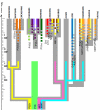Parallel evolution of genes and languages in the Caucasus region
- PMID: 21571925
- PMCID: PMC3355373
- DOI: 10.1093/molbev/msr126
Parallel evolution of genes and languages in the Caucasus region
Abstract
We analyzed 40 single nucleotide polymorphism and 19 short tandem repeat Y-chromosomal markers in a large sample of 1,525 indigenous individuals from 14 populations in the Caucasus and 254 additional individuals representing potential source populations. We also employed a lexicostatistical approach to reconstruct the history of the languages of the North Caucasian family spoken by the Caucasus populations. We found a different major haplogroup to be prevalent in each of four sets of populations that occupy distinct geographic regions and belong to different linguistic branches. The haplogroup frequencies correlated with geography and, even more strongly, with language. Within haplogroups, a number of haplotype clusters were shown to be specific to individual populations and languages. The data suggested a direct origin of Caucasus male lineages from the Near East, followed by high levels of isolation, differentiation, and genetic drift in situ. Comparison of genetic and linguistic reconstructions covering the last few millennia showed striking correspondences between the topology and dates of the respective gene and language trees and with documented historical events. Overall, in the Caucasus region, unmatched levels of gene-language coevolution occurred within geographically isolated populations, probably due to its mountainous terrain.
Figures






References
-
- Abdushelishvili MG. Antropology of the ancient and contemporary population of Georgia. Metsniereba; Tbilisi: 1964.
-
- Abramova MP. The Central Caucasus in the Sarmatian epoch. In: Rybakov BA, editor. The steppes of the European part of the USSR in the Scythian-Sarmatian time. Nauka; Moscow: 1989. pp. 268–281. (Series Archaeology of the USSR).
-
- Ageeva RA. Which tribe we are? Ethnic groups of Russia: ethnonims and fortunes. Ethnolinguistic dictionary. Academia Press; Moscow: 2000.
-
- Alexeev VP. The origin of Caucasus peoples. Mysl; Moscow: 1974.
-
- Alexeev ME. Languages of the world: Caucasus languages. Academia; Moscow: 1999. Nakh-Dagestan languages; pp. 156–165.
Publication types
MeSH terms
Grants and funding
LinkOut - more resources
Full Text Sources

